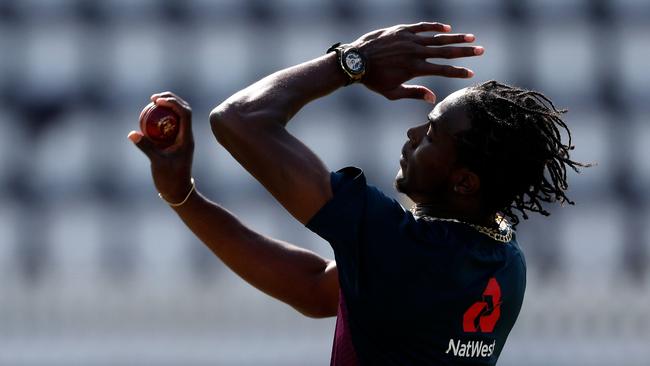Ashes 2019: Is this the man to tame Steve Smith? Jofra Archer can live up to hype
Jofra Archer can ask questions of Steve Smith that England have not been able to in the past seven Tests.

It is hard to think of an England debut in recent years that has been more hotly anticipated than that of Jofra Archer’s today.
You have to go back 14 years to Kevin Pietersen’s Test debut against Australia at Lord’s, or maybe 14 years before that to Graeme Hick’s long-awaited bow against West Indies at Headingley. As imports who had to bide their time, both will have a keen understanding of what the Sussex fast bowler is feeling this morning.
Pietersen’s impact was immediate and resulted in a great, if tumultuous, England career; Hick’s was less startling and the returns — an average of 31.32 from 65 Tests — never quite matched the initial expectation and hype. Archer may be buffeted more by the slings and arrows of fortune than either, injuries being a key determinant of a bowler’s longevity, but my guess is that, with a fair wind and a dollop of good luck, the 24-year-old will have a very significant England career. There is so much to look forward to.
Hick faced two issues that will not affect Archer.
Born in Zimbabwe, he had to wait seven years to play Test cricket by which time he was already 17,000 first-class runs into his career, the edge dulled by too much county cricket for Worcestershire. Nor had he spent any time around the England dressing room by the time he came into it. “I didn’t know anyone really,” he later said. “I did feel like a foreigner in the dressing room.”
World Cup advantage
Archer, who has an English father and was born in Barbados, would have had to wait seven years had the regulations not been changed, sneakily, just in time for the World Cup. Otherwise he might have been lost to international cricket for good, or, if not, three prime years of what is a short career as a fast bowler would have been spent at a lower level.
The seven-week experience in the World Cup, when he took 20 wickets, will be invaluable for him now: he knows the players, the coaching staff, the set-up, and they know him. He is not coming in cold, as Hick did; he starts, instead, like Pietersen, who had the benefit of a one-day tour to South Africa and Zimbabwe before his Test debut.
The World Cup, and especially the closing stages of it, put to rest any questions about Archer’s temperament.
From first ball to last, he looked made of, what the American writer Tom Wolfe called in respect of fighter pilots, “the right stuff”. He expected to bowl the Super Over in the final against New Zealand after the teams had tied and did not shy away from the responsibility. His broader experiences in the Indian Premier League and the Big Bash League, in front of large and boisterous crowds, will clearly stand him in good stead.
Test cricket challenges batsmen and bowlers in different ways, though: for batsmen, the five-day game becomes more of a mental test; for bowlers, especially fast bowlers, the challenge is physical. Test matches are arduous; five-match series, even more so.
Next time you see a former Test bowler, ask him how his back is, or how his knees, hips and ankles are holding up — and be prepared for a long conversation. It is physically very demanding.
That was, of course, what Justin Langer, the Australia head coach, was referring to in the build-up to the game about wanting his batsmen to take Archer into third and fourth spells. Will he be as quick on the second day as the first?
How will his stamina hold up if he has to send down 20 overs or more two days running? How will he cope with back-to-back Tests, with four Tests in a month?
He’s quick, very quick
He looks an athlete — wiry, strong and loose-limbed — and fast bowlers from the Caribbean have generally coped better than most, but these are unknowns to some degree.
He has not played a first-class match since September last year and has bowled fewer than 1000 overs in his first-class career, a fifth the amount that John Snow, for example, the former Sussex and England fast bowler, had sent down before his England debut.

So much for the unknowns. What do we know? We know he is quick, very quick.
On the face of it, there does not seem much of a difference between bowlers who operate at 136kmh to 145kmh and 145kmh-plus, but batsmen will tell you there is.
It is the difference between being able to really see the ball and having to play it on instinct and feel, hoping the cues you pick up as a professional allow you to sense where the ball is. These bowlers, the genuinely quick bowlers, are few and far between and precious.
Archer is in that bracket and will ask questions of Steve Smith, for example, that England have not been able to in the past seven Tests, when Smith has plundered runs for fun and Australia have won six of those matches.
England haven’t had many genuinely quick bowlers throughout their history. Mark Wood is another, but he is a fast bowler in a medium pacer’s body, and the strain he puts on himself trying to bowl like the wind means that he misses more matches than he plays, and explains why he is injured once more. But when Wood did play Test cricket last, in St Lucia in February, the effect was startling, as it is whenever a hurricane blows in. England’s great triumph in 2005 was built on three fast bowlers — Simon Jones, Steve Harmison and Andrew Flintoff — and, intermittently down the years, many good periods against Australia have coincided with an England captain having pace at his disposal — Bob Willis, Snow and Frank
Tyson, for example.
Left-handers beware
The other eye-catching part of Archer’s make-up is how close to the stumps he delivers the ball, which should make him a very dangerous bowler to left-handers, especially. Australia have four of those in the top six — David Warner, Usman Khawaja, Travis Head and Matthew Wade — and they will know, as every left-hander does, that bowlers who deliver from tight to the stumps increase their chances of bringing all dismissals into play, because they are able to pitch on the line of the stumps far more frequently than those who bowl from wide of the crease.
Archer has played only one first-class match at Lord’s — he took eight wickets for Sussex against Middlesex last summer — and sometimes bowlers who have not played there much can be disorientated by the slope and the adjustment required. Most line bowlers (as opposed to swing bowlers) tend to operate from the Pavilion End, and in James Anderson’s absence (Anderson, unusually for an outswing bowler, likes the Pavilion End) Archer looks a natural fit for that end. Think of Glenn McGrath (26 Test wickets at an average of 11.50 in three Tests at Lord’s) and Curtly Ambrose (17 at 21.58 in four Tests) who used the slope magnificently from the Pavilion End to get right-handers playing at balls they should have left alone — which should be Archer’s aim this week.
Most of all, the effect of having a genuinely fast bowler is psychological — as England found when Mitchell Johnson blew them away in a whitewash five years ago. There is nothing worse for a captain than feeling outgunned, as Joe Root was throughout the 2017-18 Ashes tour when Australia’s bowlers were significantly quicker. When all the niceties discussed above are put to one side, the bottom line is that, while some play it better than others, very few batsmen relish facing quick bowling.
It was Mike Tyson who said: “Everyone has a plan until they get punched in the mouth.”
Fast bowlers have a way of disrupting the best-laid plans.
The Times
Don’t miss a ball of the Ashes action. Follow our LIVE BLOG.




To join the conversation, please log in. Don't have an account? Register
Join the conversation, you are commenting as Logout